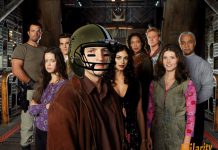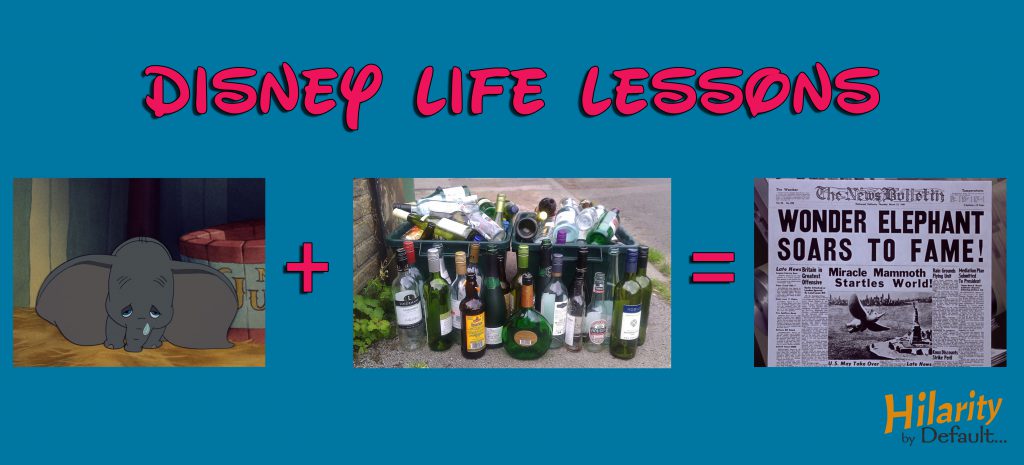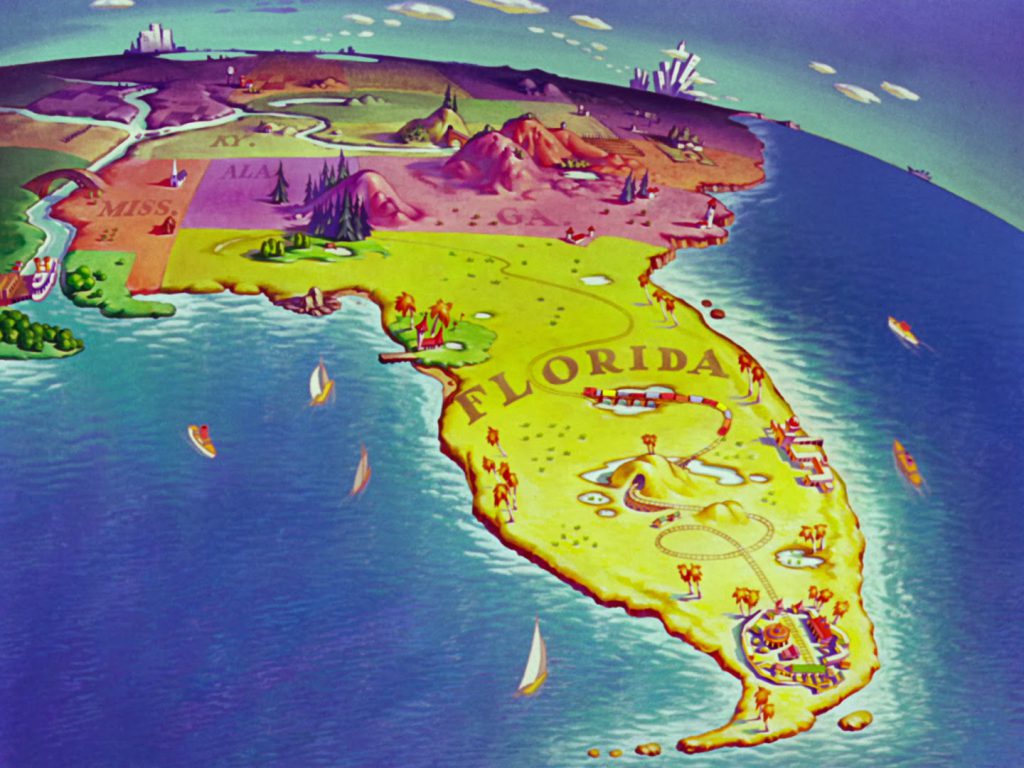Towards the end of 1941, life at the Disney Studios was chaotic. With the failures of Pinocchio, Fantasia, and even The Reluctant Dragon, World War II cutting off half of their release markets, and the Disney animator’s strike, the studio was desperate for a hit. Thankfully they found it in the poignant story of a baby elephant named Dumbo.
Produced at a fraction of the cost of their previous animated efforts, Dumbo soared at the box office. Although not nearly as successful as Snow White and the Seven Dwarfs, Dumbo‘s underdog story struck gold with American audiences who were only mere weeks away from the attack on Pearl Harbor and America’s entrance into the War.
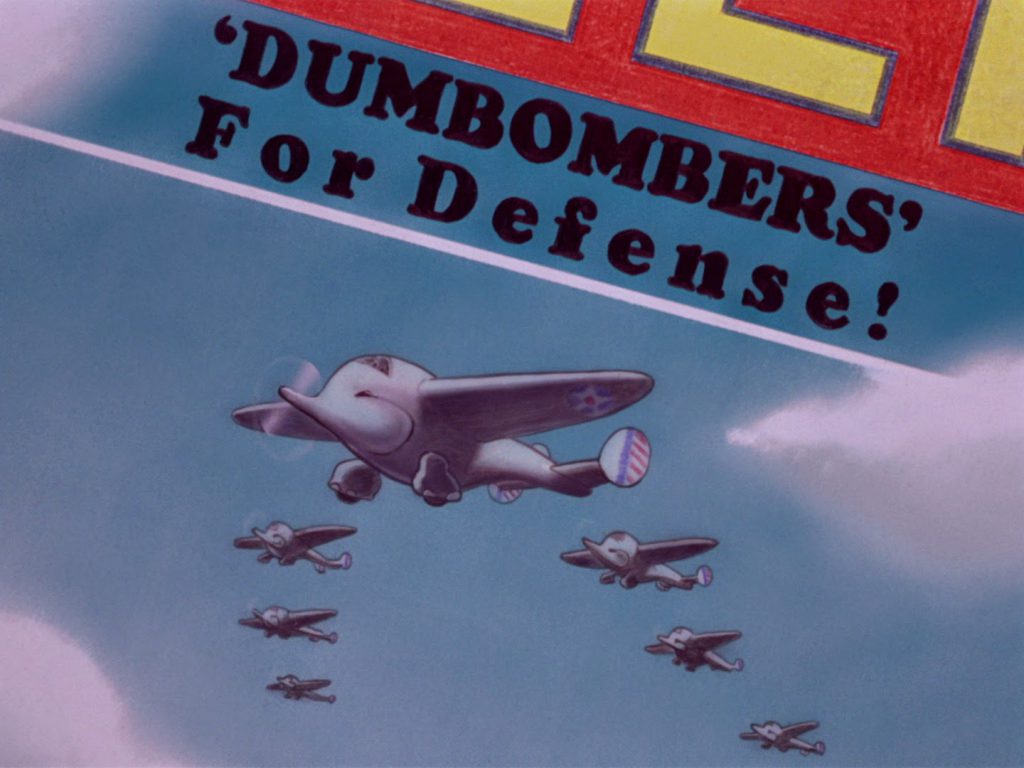
Walt Disney’s Dumbo |
Dumbo is one of Disney’s shortest animated films. Clocking in at a few minutes past an hour, it is a brief, but nevertheless, delightful experience. It’s the story of an infant elephant named Jumbo Junior who, due to his oversized ears, sparks the antipathy of his fellow circus folk. The other elephants deride him by nicknaming him Dumbo, calling him a freak and even, at one point, an assassin!
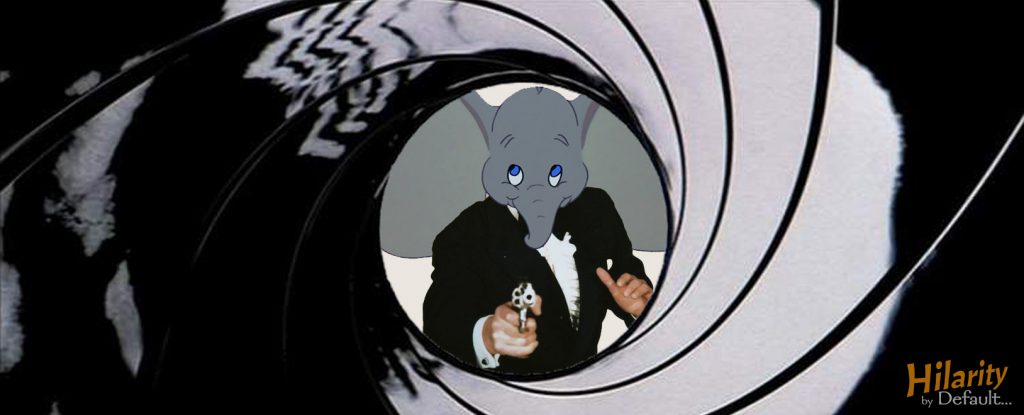
After his mother is chained up and confined for protecting him after a particularly nasty taunting from some youths, his little life spirals downward until he suffers the circus’ worse humiliation – being turned into a clown. With the help of a gallant mouse named Timothy (Edward Brophy), he overcomes these obstacles and turns his deformity into triumph when he discovers that his large ears allow him to fly.
Also weaved throughout the film are several allusions to other famous children’s fables such as “The Little Engine That Could,” told through the circus train Casey Junior, and the myth of storks delivering babies (which apparently dates back to ancient mythology).
On a side note, the stork mythos has always puzzled me. It’s the same story my parents told me when I asked them where babies came from. Being a precocious young child, I found this explanation quite odd. If it were true, I thought, then why wasn’t a stork present in Christmas nativity scenes…
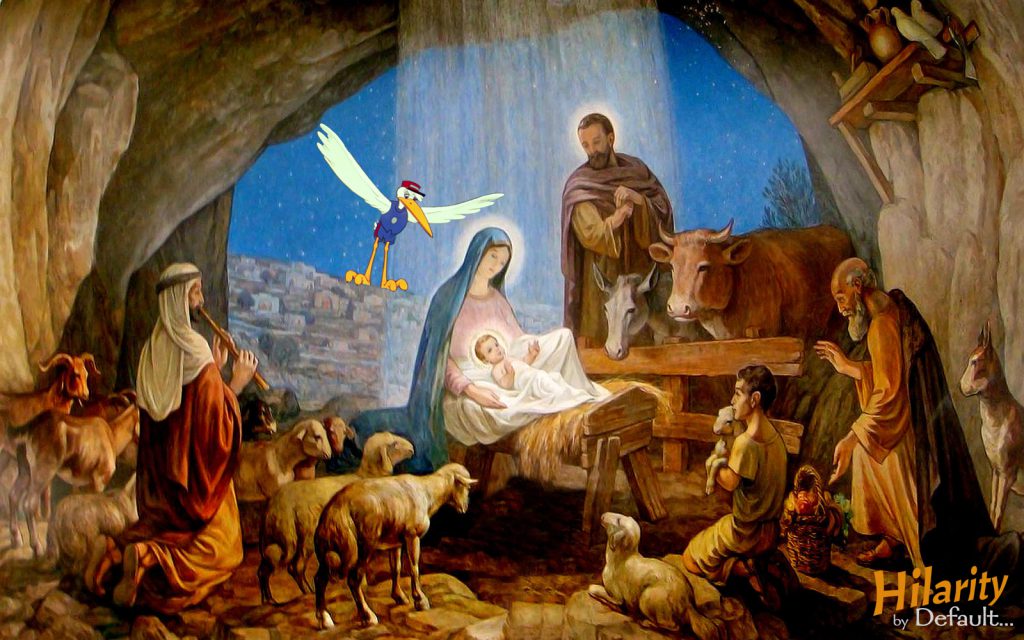
…or, consequently, how were babies delivered aboard the USS Enterprise in Star Trek…
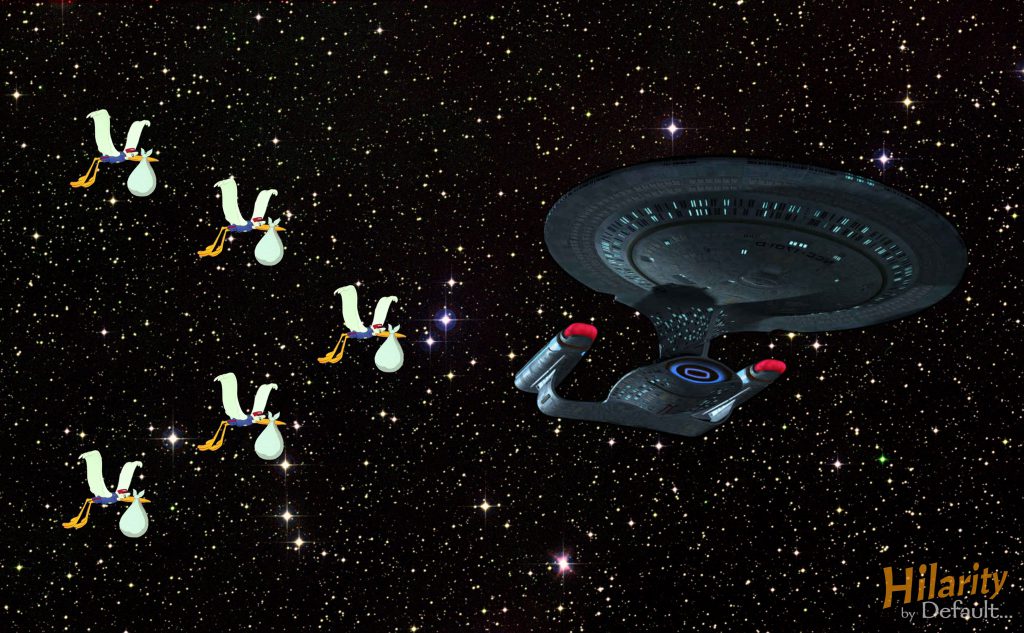
…but I digress. Dumbo is a joyful achievement. True, it does have a heavy dose of saccharine and sentimentality (especially when compared to the previous films in the canon) but the film is compelling and it is hard not to yearn for the little tyke to succeed. In a number of ways, it is one of Disney’s saddest films. After cleverly setting up the innocent love between Dumbo and his mother only to tear it apart, the film grabs hold of your heartstrings tightly and never lets up. To add that Dumbo never utters a single word throughout the film and yet still captivates such strong empathy from its audience is an example of the mastery of Disney storytelling and character animation.
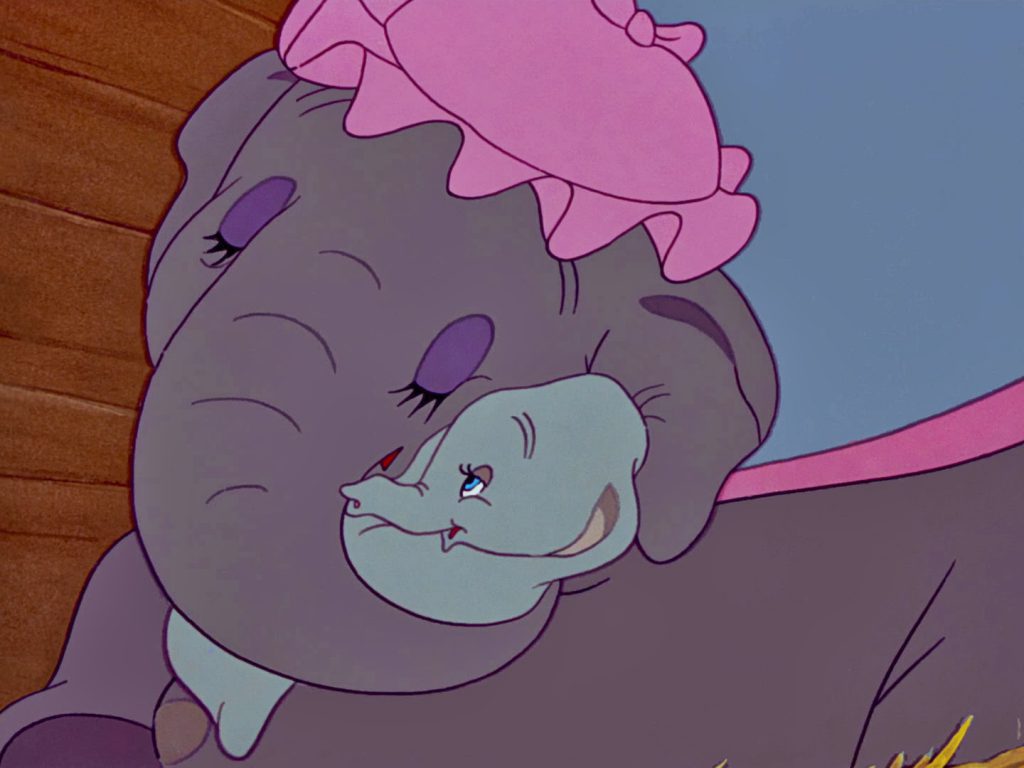
Professor Hoot and the Crow Choir |
Based on the children’s book by Helen Aberson and Harold Pearl, Dumbo is quite faithful to its source material save for a few wise alterations. While Dumbo’s mother (here named Ella instead of Mrs. Jumbo) is never barricaded as a mad elephant, she still has to sit back in horror as her baby, Jumbo, becomes the laughing stock of the circus and they are both punished by being secluded in the donkey car of the circus train. Fed up with humiliation after humiliation, Jumbo (now nicknamed Dumbo by the circus), decides to run away.
He meets a friendly robin named Red, who, upon hearing Dumbo’s harrowing life story, decides that he is in need of psychiatric help. The robin takes him to meet “Professor Hoot Owl, M.D., Ph.D., M.A., L.L.D. Psychiatrist and Notary Public” (clearly, this owl would make a killing practicing in Los Angeles). The owl analyzes Dumbo’s recurring dreams of flying and deduces that they are directly connected to a hidden, innate talent. After forcing the baby elephant to jump off a cliff, Red teaches him to fly and, just like the film, Dumbo becomes a bonafide star after a performance at Madison Square Garden.
Disney’s version improves on the original story in many ways. By separating Dumbo from his mother, it eliminates his familial support and gives him a worthier ambition. Additionally, he never runs away from the circus in the film but still clings on to the meager hope that he can be reunited with his mother.
Red the robin, in a brilliant twist, gets changed to a mouse – an elephant’s mortal enemy. Not only does this open up a variety of comic possibilities, but, more importantly, it sets Dumbo apart as a character by showing that he has the ability to overcome the very similar prejudices that have afflicted his life by befriending the mouse.

In the tradition of Jiminy Cricket, Timothy provides a rational voice in the picture with a refreshing sense of optimism. If a little mouse can have the confidence and headstrong charisma that Timothy conveys, then perhaps there is hope for Dumbo after all. His character does not undermine or pacify the film’s message; rather, it skillfully accentuates it.
Professor Hoot Owl (and his various acronyms and credentials) is replaced, quite notoriously, by a murder of crows. Not only do they sing what is considered the most memorable song in the film, “When I See an Elephant Fly,” but they are as instrumental in helping Dumbo take flight as they are entertaining.
In recent years, the portrayal of the crows has been accused of being racist towards black Americans. Although the crows do speak with black lingo of the time and sing a jive song, I never quite got the impression that it was meant to be a hurtful or negative portrayal. In hindsight, Dumbo is the story of a character who is ostracized by the majority solely because he looks different. By this reasoning, the fact that the crows (if they are indeed racial representations) decide to join and support him to overcome this adversity only purports to impart a positive message. These are not caricatures to be laughed at but rather intelligent characters who engage in clever wordplay as evidenced through the song they sing. They may be a bit stereotypical, true, but the film’s harsher accusations seem a bit overblown. Consider it lucky that Disney hasn’t banned the film (like Song of the South) or worse:
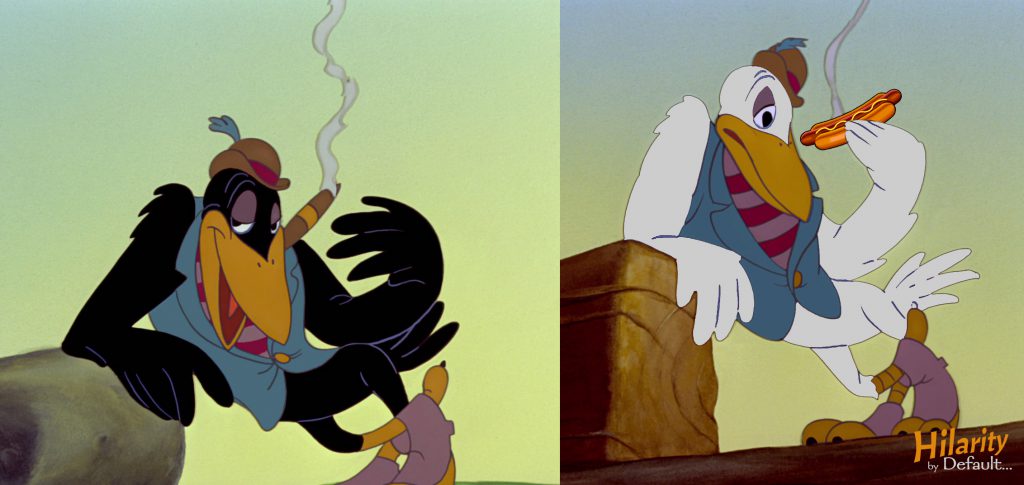
I sometimes wonder if movies like DreamWorks’ Shark Tale will be viewed as racist decades from now because the lead fish is clearly designed and written to be representative of its voice actor, Will Smith. It doesn’t sound extreme when one considers the fact that the crows were also mostly voiced by black singers from the Hall Johnson Choir, a famous, and extremely talented, group of musicians formed by the eponymous Johnson. Johnson was a pioneering black singer, composer, and writer who had the ambition of introducing Afro-American rhythm and music to the masses. Their performances in Dumbo and Song of the South (as well as the 1940 musical Cabin in the Sky which featured an all-black cast – something that was quite daring at the time) widened their already successful appeal, especially among children. Subsequently, it is disheartening to see something written off in the harshest way imaginable without consideration of the original intent or historical and cultural significance.
Besides, there are many elements in the early Disney films that can convey an altogether different meaning if one looks at them solely through modern eyes. If Dumbo were created and released today, it would be an entirely different species. For instance, the film would never have been called Dumbo (lest we offend anyone!) let alone have the crows portrayed in the same way. In many ways, what was once innocuous in the past can sometimes be considered devastating in the future, such as the implications presented in the following scene if one had their head in the gutter:
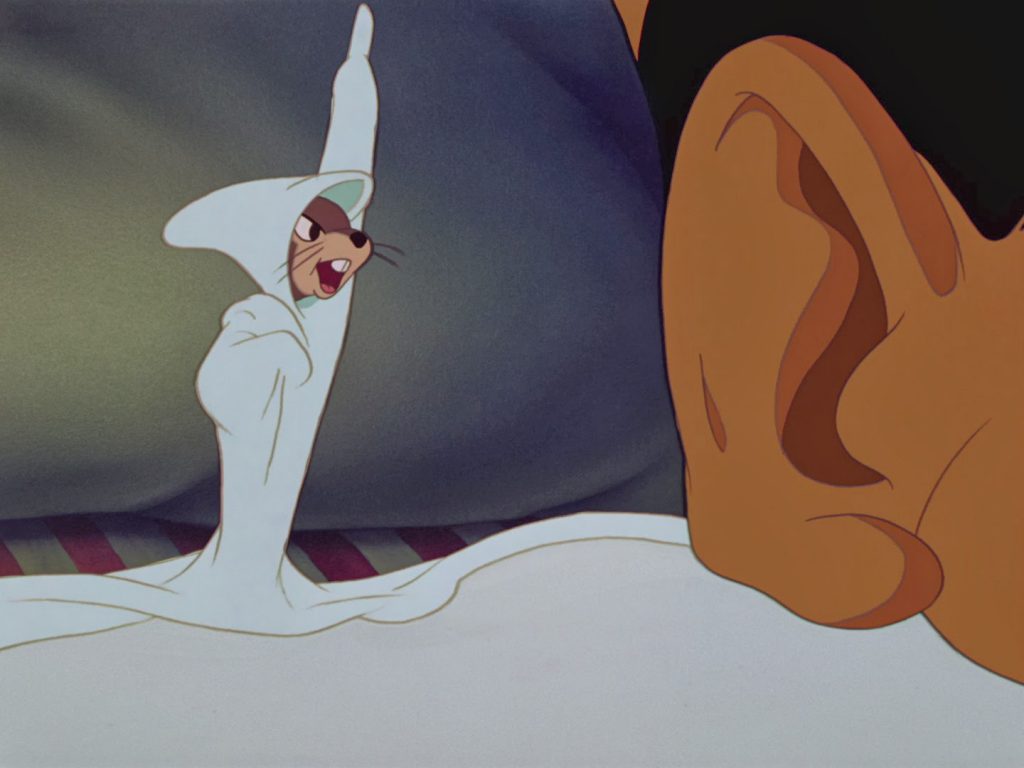
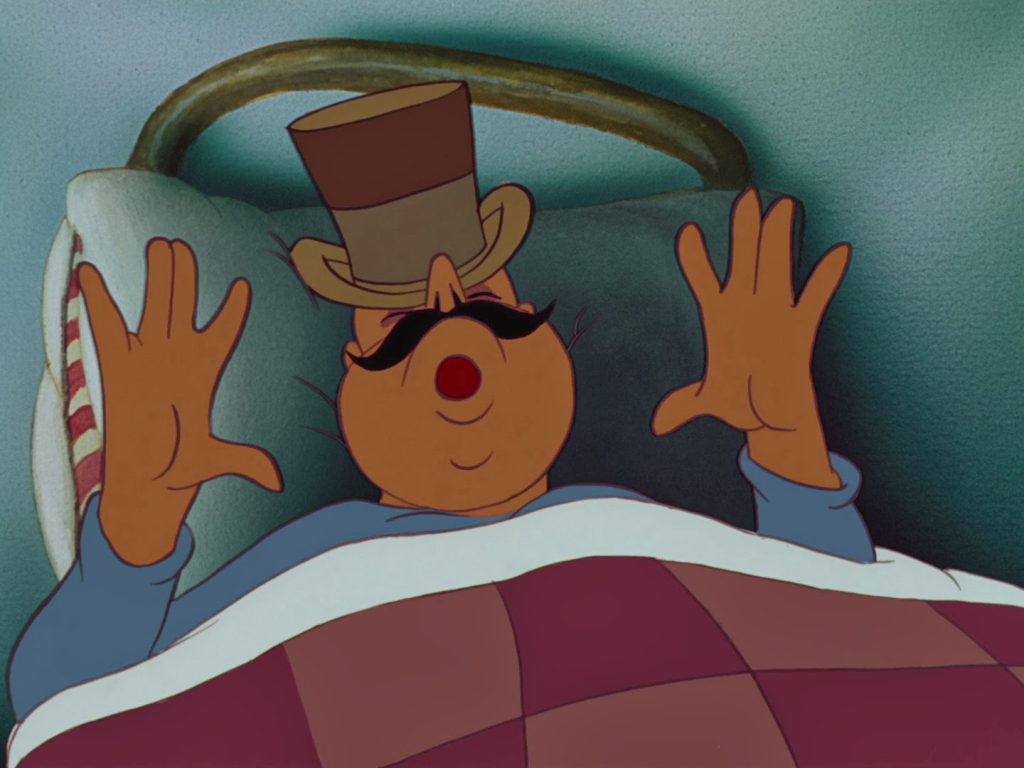
The Animation and Intoxicated Terror of Dumbo |
The animation in Dumbo is a significant step down when compared to its Disney predecessors. The film was completed quickly with a curtailed budget and it shows, especially in contrast to Bambi which was still in the midst of its very long production at the time.
The film doesn’t have the rich detail that adorned the studio’s previous efforts and, at times, its lack of polish can be a bit distracting. Heck, during “Song of the Roustabouts,” the human characters don’t even have faces!
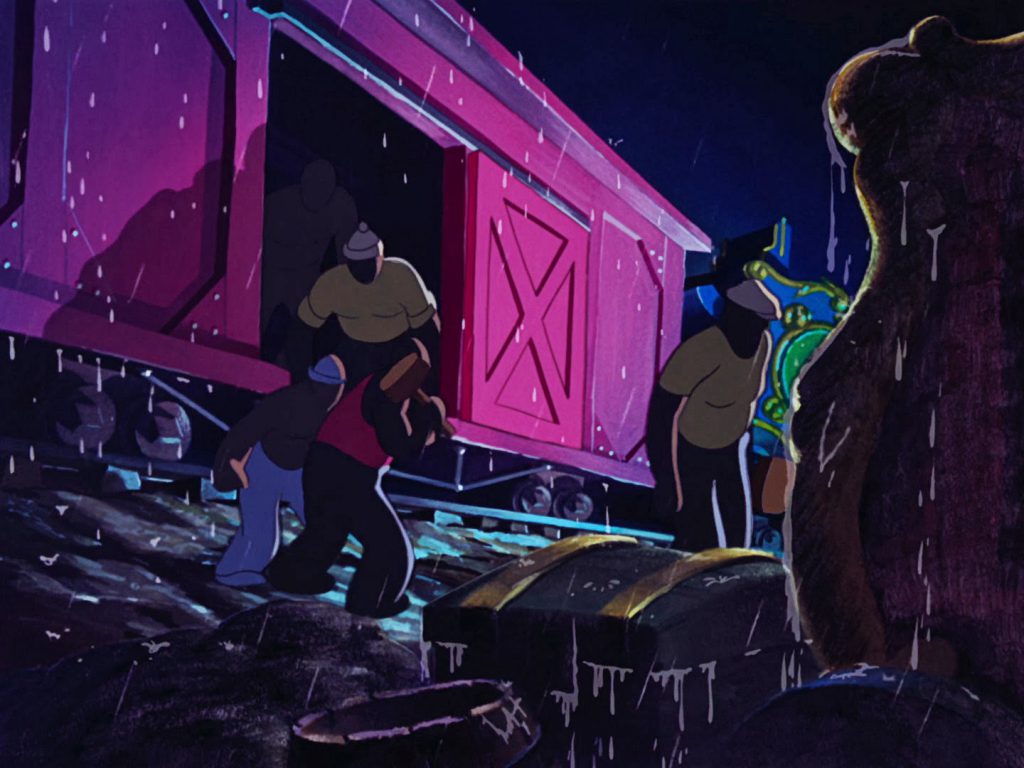
It could be argued that this was done artistically to illustrate the faceless behind-the-scenes work force of the circus (after all, this isn’t done with other human characters in the film, save for large crowd shots). While this can be understandable to a point, it does let down the “Roustabouts” episode which is one of the most visually impressive scenes in the film otherwise.
Moreover, there are many moments where the main characters briefly mutate into simpler sketches of their former selves…
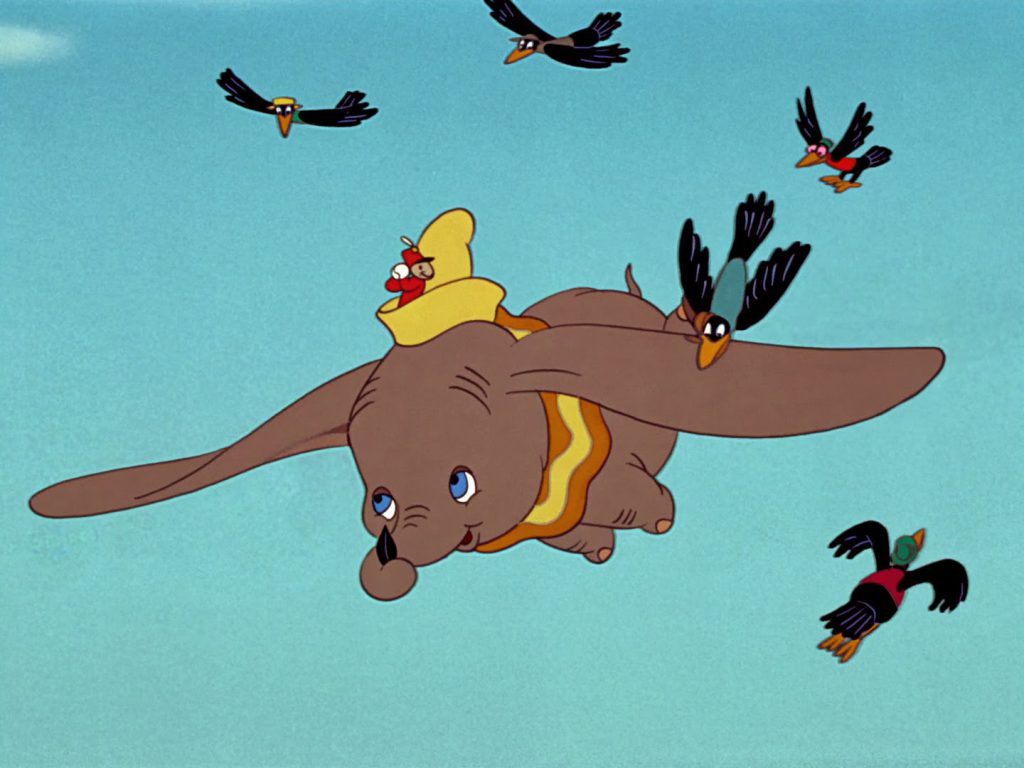
At other times, it is incomplete and jumpy. Case in point, in one scene, the animation of Timothy Mouse running up Dumbo’s trunk is left half-finished. He vanishes and reappears on another spot of his trunk between frames making it look like the rodent has the power of teleportation (let’s face it, in a film featuring avian pachyderms, a teleporting mouse wouldn’t be too far-fetched).
Despite its limitations, there are a couple of standout sequences – some of which are accomplished enough to be considered alongside some of Disney’s better animated films. The “Pink Elephants on Parade” section, for instance, has long been cited as an arresting achievement. In it, Dumbo and Timothy become intoxicated after accidentally drinking a bottle’s worth of champagne. What begins with some amusing antics as the two gleefully play with bubbles devolves into a terrifying, surreal nightmare.
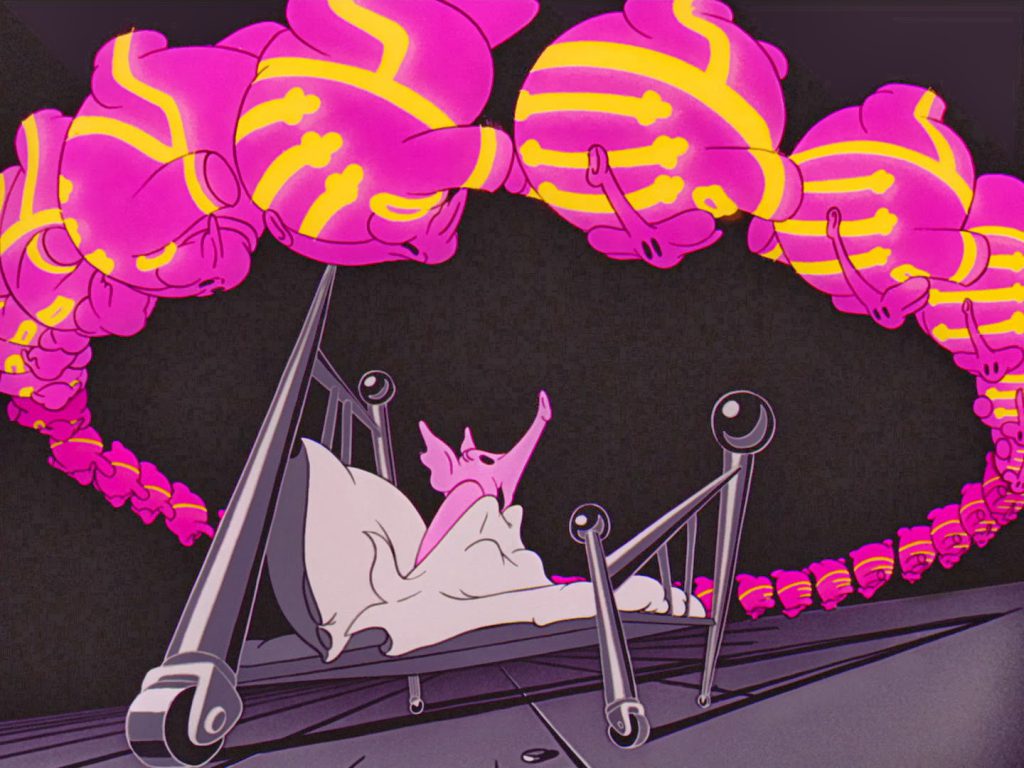
Just what the hell was in that champagne anyway (and how can I legally get some)? Not only does it give Dumbo and Timothy strangely communal hallucinations, but it also literally gets them high as they end up stuck in a tree.
The scene may be creepy but it still manages to remain within the confines of the narrative (the same cannot be said for the similar, but far more trippy, ending sequence of The Three Caballeros). It’s pivotal to the story as it unlocks Dumbo’s hidden ability of flight but does it really send the right message? Apparently alcohol and drunkenness can solve your problems or even liberate previously unknown superpowers!
Regardless, “Pink Elephants on Parade” is a tour-de-force and the song is catchy and effectively eerie.
Where Dumbo really excels, however, is in the individual character animation. The design of Dumbo himself is quite a feat. Without dialogue, the gamut of emotions communicated through his facial expressions is exceptional. In fact, Dumbo may be the paragon example of character animation used to illustrate a whole range of dialogue or emotions through body language.
Dumbo won the Oscar for its incredible musical score and it was a much-deserved accomplishment, from the memorable tunes of “Casey Junior” to the rollicking “When I See an Elephant Fly.” What sets the songs apart in contrast to the other Disney features up to this time is that none of the characters actually sing any of them save for “The Clown Song” (which is 20 seconds long) and the crows’ “When I See an Elephant Fly.” Alternatively, most are sung by off-screen choruses such as The Sportsmen or The King’s Men. It works well within the context of the film and it is especially emotive with the Oscar-nominated “Baby Mine” – a song that I dare anyone not to get moved by. Sure, it’s the embodiment of the sometimes cloying nature of the film, but it is just set up so beautifully that it is hard to escape the cascading emotional tsunami of sentiment in the scene.
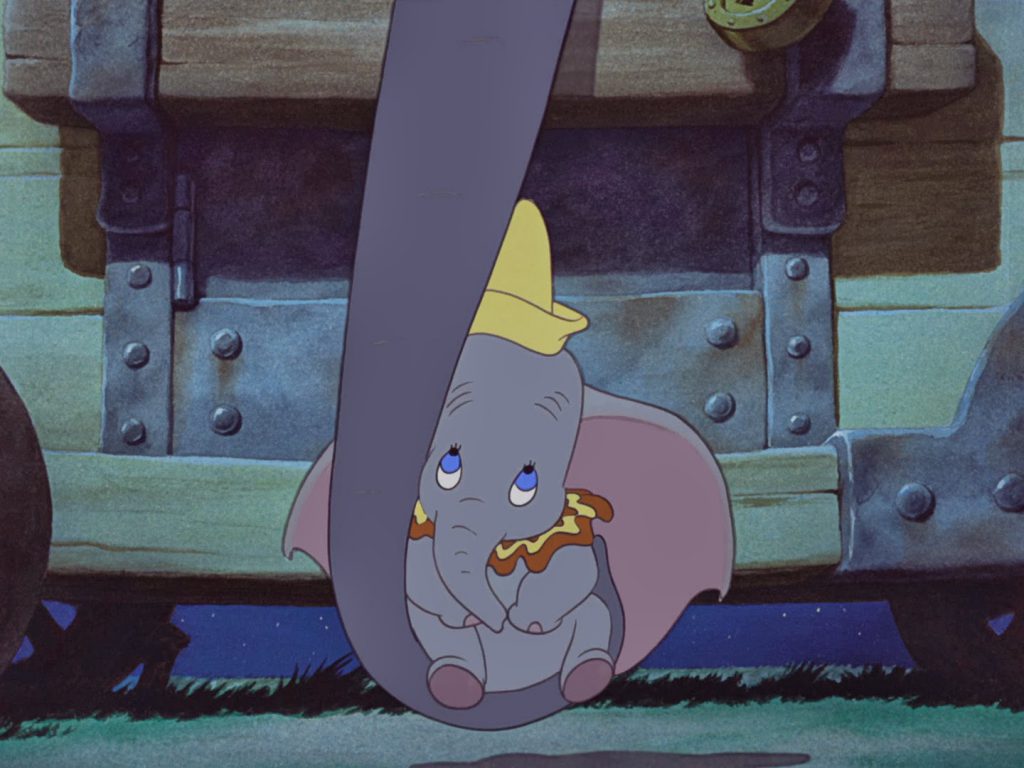
Final Thoughts |
While it may not be a triumph in animation, Dumbo is a victory in elementary storytelling. In a way, the simpler animation may do the film justice because it doesn’t distract from the more intimate journey presented. It’s not hard to see why it was such a success at the time. Dumbo‘s underdog story resonated with film audiences in a world being devastated by war. Its hopeful message of overcoming insurmountable odds struck the right chords with everyone who saw it. With some of Disney’s most memorable and engaging characters paired up with one of their best musical scores, Dumbo is an achievement and a sign of promise for the struggling Disney Studio.
Man-Card Retribution |
I would defend that it is a show of confidence for an adult male to admit that he likes Dumbo. It’s a captivating story of how one can overcome their disadvantages and struggles, not dissimilar to rooting for a hometown team that hasn’t won a game in years. There’s not much that anyone can say that would make me change my mind…

Fine, just take it!
Man-Card Verdict: -1
Random Afterthoughts… |
I always found it oddly appropriate that when Mr. Stork (Sterling Holloway) is about to deliver Dumbo, the circus train is passing close to where the future site of Walt Disney World would eventually be thirty years later.
Wait a second – are those small mountains near the middle of the state? Since when does Florida have mountains?

Speaking of Mr. Stork, just what kind of “service” (his own words) is Mrs. Jumbo subscribed to? Not only does he arrive days late, but he delivers a defective product (cruel, but just run with me here for a second). He almost loses his cargo on an errant cloud and has trouble with directions but at least he has a neat uniform which the other delivery storks lack. Heck, he even sings “Happy Birthday” to Dumbo while he’s still in a sack which would be akin to, I guess, a doctor singing “Happy Birthday” to a woman in the midst of labor! If this was set in modern times, I could see a potential lawsuit…

Join us next time for our ongoing look at the Disney animated shorts. Teased last month in our Default Disney review of the “The Skeleton Dance,” we will be taking a look at the cartoon short that introduced the ever-exasperated Donald Duck to the world – “The Wise Little Hen.” For more Default Disney, click here.












